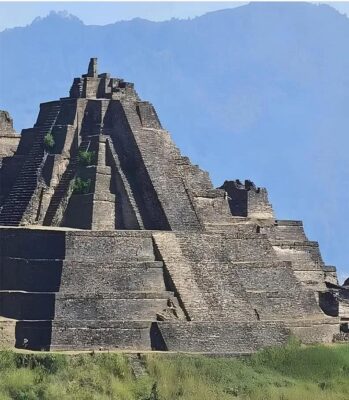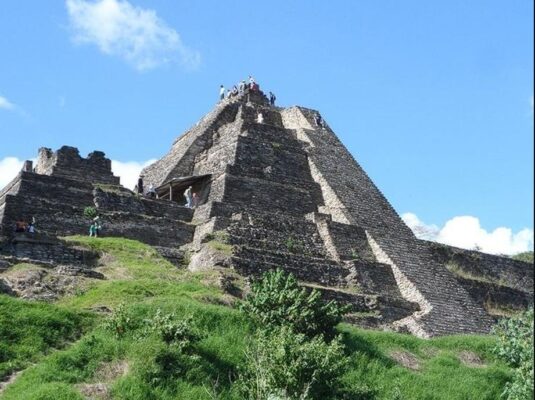Why does one of the tallest pyramids in the Americas remain relatively unknown? The Great Pyramid of Toniná, nestled in the heart of Chiapas, Mexico, stands as a testament to the Maya civilization’s architectural prowess and spiritual depth. Despite its monumental scale, it remains an overlooked archaeological treasure, offering a unique window into the ancient Maya world.
Unveiling the Enigma of Toniná
The Great Pyramid of Toniná’s relative obscurity is a puzzle, considering its size and historical significance. Understanding its context reveals the complexity of Maya civilization and the challenges of archaeological exploration.
Geographical Isolation and Accessibility
Toniná’s location in the highlands of Chiapas, while strategically advantageous in ancient times, contributes to its modern-day obscurity.
- Highland Setting:
- The site’s location in the mountainous region of Chiapas, away from major tourist routes, limits its accessibility and visibility.
- It is located in the mountains.
- Limited Infrastructure:
- Compared to more popular Maya sites like Chichen Itza or Tulum, Toniná has less developed tourist infrastructure, affecting visitor numbers.
- It has less tourist infrastructure.
- Exploration Challenges:
- The rugged terrain and dense vegetation surrounding Toniná present challenges for archaeological exploration and excavation.
- It is difficult to explore.
Historical Context and Rivalries
Toniná’s historical context, marked by intense rivalries and warfare, offers insights into its strategic importance and eventual decline.

- Rivalry with Palenque:
- Toniná was a fierce rival of Palenque, a major Maya city-state, and engaged in frequent warfare, shaping its political and architectural development.
- It was a rival of Palenque.
- Dominant City-State:
- During its peak, Toniná was a dominant city-state, exerting influence over a wide region and leaving behind a legacy of powerful structures.
- It was a powerful city.
- Maya Warfare:
- The city’s history is intertwined with Maya warfare, as evidenced by its defensive architecture and numerous depictions of captives and battles.
- It was involved in many wars.
Architectural and Spiritual Significance
The Great Pyramid of Toniná’s design reflects the Maya’s deep spiritual beliefs and architectural ingenuity.
- Seven Massive Platforms:
- The pyramid’s construction across seven massive platforms symbolizes the Maya belief in ascending through different realms, including the underworld.
- It has seven levels.
- Ascending Through Realms:
- The tiered structure represents a symbolic journey through the cosmos, reflecting the Maya’s cosmological worldview.
- It represents a spiritual journey.
- Spiritual Significance:
- The pyramid served as a sacred space for rituals and ceremonies, highlighting the spiritual significance of Toniná in the Maya world.
- It was a sacred space.
The Architectural Marvel of Toniná
The Great Pyramid of Toniná stands as an architectural marvel, showcasing the Maya’s advanced engineering skills and artistic expressions.
Monumental Scale and Design
The pyramid’s impressive scale and unique design distinguish it from other Maya structures.
- Height and Size:
- Rising over 75 meters (246 feet), the pyramid is one of the tallest in the Americas, surpassing the Pyramid of the Sun at Teotihuacan.
- It is very tall.
- Terraced Construction:
- The pyramid’s terraced construction, with its seven platforms, creates a visually stunning and architecturally complex structure.
- It is terraced.
- Integration with Landscape:
- The pyramid’s design integrates seamlessly with the surrounding landscape, highlighting the Maya’s understanding of natural topography.
- It fits into the landscape.
Intricate Carvings and Sculptures
Toniná is renowned for its intricate carvings and sculptures, which provide valuable insights into Maya history and culture.

- Depictions of Captives:
- Numerous carvings depict captives and warriors, reflecting Toniná’s history of warfare and its role as a powerful city-state.
- It has carvings of warriors.
- Symbolic Imagery:
- The sculptures and carvings feature symbolic imagery related to Maya mythology and cosmology, revealing the city’s spiritual significance.
- The carvings have spiritual meaning.
- Artistic Skill:
- The craftsmanship of the carvings and sculptures showcases the Maya’s artistic skill and attention to detail.
- The carvings are very detailed.
Urban Planning and Structures
Toniná’s urban planning and other structures reveal the city’s sophisticated organization and architectural achievements.
- Acropolis and Ball Court:
- The site features an acropolis, ball court, and other structures, demonstrating the city’s complex urban layout and social organization.
- It has many structures.
- Defensive Architecture:
- Toniná’s defensive architecture, including walls and fortifications, reflects its strategic importance and history of warfare.
- It has defensive structures.
- Astronomical Alignments:
- Like other Maya sites, Toniná’s structures may have been aligned with astronomical events, highlighting the Maya’s advanced understanding of astronomy.
- It may have astronomical alignments.
Toniná’s Legacy and Modern Discovery
Toniná’s legacy as a powerful Maya city-state and its rediscovery in modern times contribute to our understanding of ancient Mesoamerica.
Archaeological Discoveries
Ongoing archaeological research at Toniná continues to uncover new insights into the city’s history and culture.
- Ongoing Excavations:
- Ongoing excavations at Toniná are revealing new structures, artifacts, and insights into the city’s past.
- Excavations continue.
- Epigraphic Studies:
- Epigraphic studies of the site’s inscriptions are providing valuable information about Toniná’s rulers, history, and political relationships.
- Inscriptions are being studied.
- Technological Advancements:
- The use of modern technologies, such as LiDAR, is helping archaeologists to map and analyze the site, revealing previously hidden structures.
- Technology is helping to map the site.
Cultural Significance
Toniná’s cultural significance extends beyond its archaeological value, contributing to our understanding of Maya civilization and its enduring legacy.
- Maya Worldview:
- Toniná’s architecture and art provide valuable insights into the Maya worldview, including their beliefs about cosmology and the afterlife.
- It shows the Maya worldview.
- Historical Memory:
- The site serves as a reminder of the Maya’s rich history and cultural achievements, contributing to the preservation of their historical memory.
- It preserves historical memory.
- Tourism and Education:
- Toniná has the potential to become a significant tourist destination and educational resource, promoting awareness of Maya culture and history.
- It can be a tourist destination.
Preservation and Future Research
Efforts to preserve Toniná and promote future research are essential for safeguarding its cultural heritage and expanding our knowledge of the Maya world.
- Conservation Efforts:
- Conservation efforts are needed to protect Toniná’s structures and artifacts from environmental damage and human impact.
- Conservation is needed.
- Community Involvement:
- Involving local communities in the preservation and management of Toniná is crucial for ensuring its long-term sustainability.
- Local communities should be involved.
- Interdisciplinary Research:
- Future research at Toniná should involve interdisciplinary approaches, combining archaeology, anthropology, and other fields to gain a comprehensive understanding of the site.
- Research should be interdisciplinary.
The Great Pyramid of Toniná, with its monumental scale, intricate carvings, and rich history, remains a hidden giant of the Maya world. Its relative obscurity only adds to its allure, offering a unique opportunity to explore the mysteries of this ancient civilization. Ongoing research and preservation efforts will ensure that Toniná’s legacy continues to inspire awe and wonder for generations to come.

CÁC TIN KHÁC
Mary Walton: The Forgotten Inventor Who Helped Clean Up America’s Cities
Tomb of Queen Nefertari in the Valley of the Queens, Egypt
Discover the Hypostyle Hall of the Temple of Hathor at Dendera
Venus de Losange: Unveiling the Mystery of a 20,000-Year-Old Paleolithic Icon